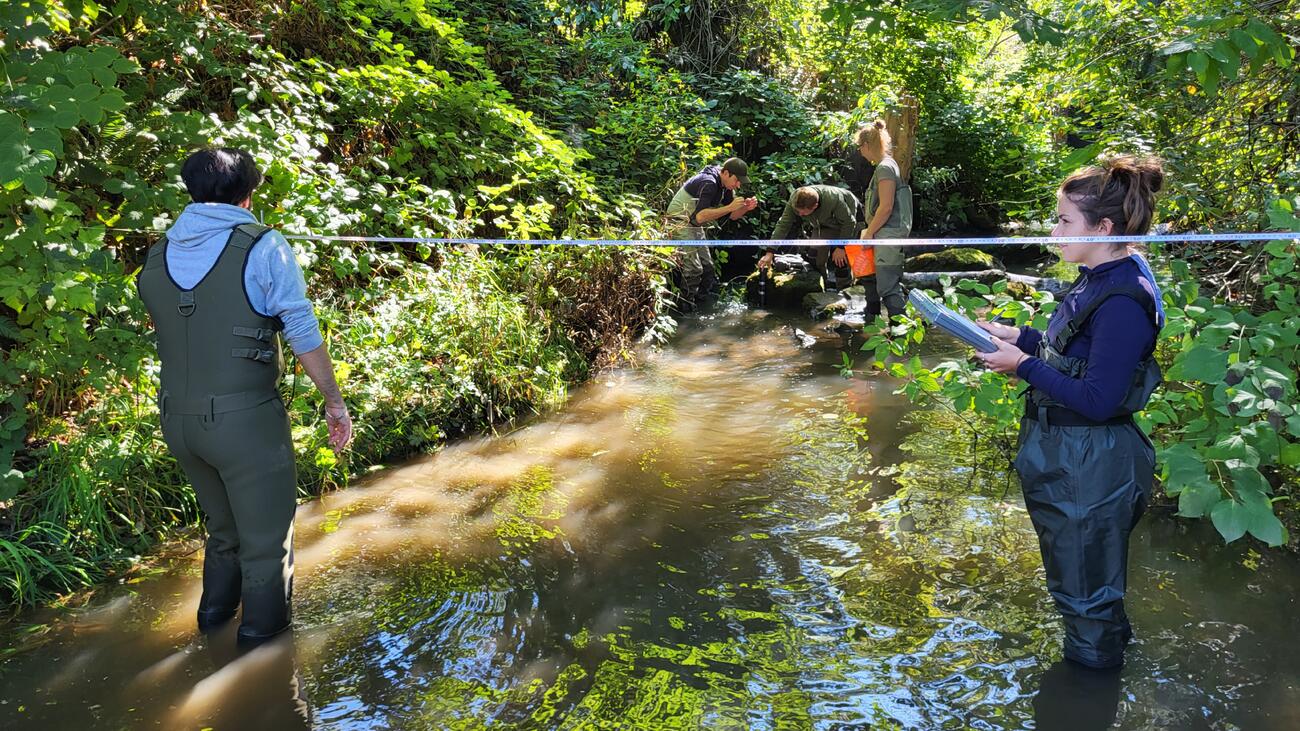UBC-led initiative protects salmon against toxic road runoffs
In this Q&A, civil engineering researchers Dr. Rachel Scholes and Dr. Timothy Rodgers discuss a toxic chemical from tires and the role of rain gardens in defusing its impacts.
The roads, bridges, and highways that crisscross BC take us where we want to go. Unfortunately, they also help leak a toxic chemical shed by car tires — 6PPD-quinone — into BC’s waterways, posing a serious threat to salmon habitats.
A collaborative project led by UBC and its partners is working to identify and mitigate these toxic hot spots. The researchers are surveying ponds, creeks, and streams across the Lower Mainland in hopes of building future rain gardens and other “green infrastructure” that can contain this toxin.
Dr. Rachel Scholes (she/her), assistant professor of civil engineering, and postdoctoral researcher Dr. Timothy Rodgers (he/him) discuss 6PPD-quinone and the role of rain gardens in defusing its impacts.
What are the impacts of 6PPD-quinone?
Scholes: 6PPD-quinone is the second most acutely toxic chemical for aquatic species, the first being parathion, a chemical war agent. Its potential ubiquity in areas affected by road runoff is concerning. While we’re still learning about the extent of the problem, evidence links 6PPD-quinone to coho deaths in Washington state, and we suspect it’s played a role in salmon deaths here in BC.
Rodgers: This compound is highly toxic to coho, leading to death within a few hours of exposure. In natural environments like streams, you can’t tell that it’s there just by looking, and that’s why understanding its impact is crucial.
How can rain gardens help address the issue?
Scholes: Rain gardens and other bio-retention systems effectively capture certain compounds and are increasingly being used in urban areas, where they play an important role in climate-change adaptation and flood management. They are already viewed as an important tool by municipal partners and regulators, so we wanted to assess if they can also help address 6PPD-quinone. Our previous research, including Tim’s modelling work, suggests they can.
Rodgers: In my PhD research, I developed a model suggesting that rain gardens could partially capture 6PPD-quinone in rainwater. Real-world testing with the City of Vancouver confirmed that 6PPD-quinone adheres to the soil and more than 90 per cent can be effectively captured.
Along with three other UBC projects, you received support from the British Columbia Salmon Restoration Fund, a program funded by Canada’s Pacific Salmon Strategy Initiative and the Province of BC. How will the new funding support your research?
Scholes: The $1.8 million allocated to my team will enable us to build on research undertaken by our STREAM project (Salmonid Toxic Runoff Exposure and Mitigation). Field studies are currently under way to assess the impact of 6PPD-quinone on urban creeks during rain events, to understand actual salmon exposure.
Rodgers: Extending our rain garden study, we’re collaborating with Surrey and Vancouver to investigate retention ponds capturing stormwater and road runoff. We’re studying how changes in rain garden designs can improve their ability to capture this chemical. Adding things like biochar, a type of charcoal made from plant and tree trimmings, can increase the soil’s ability to absorb contaminants, and we’re partnering with Vancouver to pilot bio-retention systems that incorporate biochar over the next two years.
With such a large scope to the project, what partners are you working with?
Rodgers: Our UBC team works closely with Dr. Tanya Brown’s team at Fisheries and Oceans Canada (DFO), monitoring streams in Surrey and White Rock, while Dr. Brown’s team covers the North Shore through to Burnaby. We are monitoring 20 sites to pinpoint the hot spots, where green infrastructure can be strategically placed in the future.
In the next phase, we hope to work with our municipal partners to highlight places where they can build this green infrastructure.
Scholes: Our formal partners include Surrey, Vancouver, the Salish Sea Indigenous Guardians Alliance, and Fraser Basin Council’s Salmon-Safe BC program. Our aim is to integrate our findings into municipal guidelines for stormwater runoff and green infrastructure development. We hope that our work will not only contribute to protecting salmon habitats but also enhance urban development in our region.
































